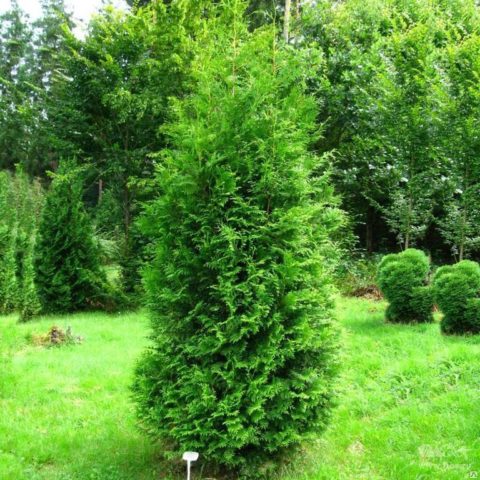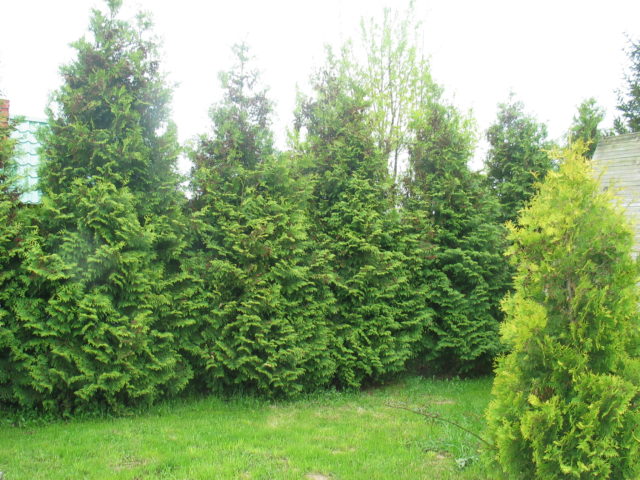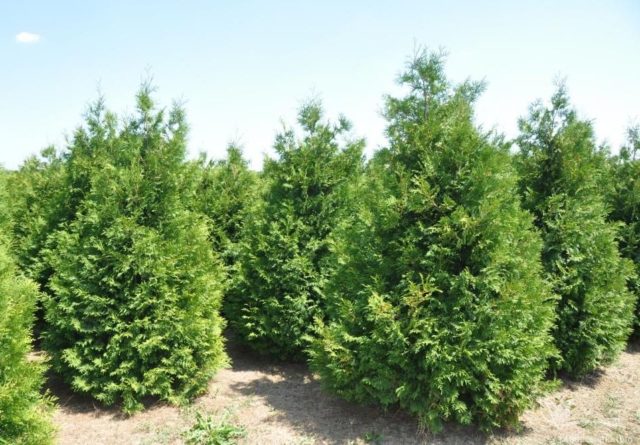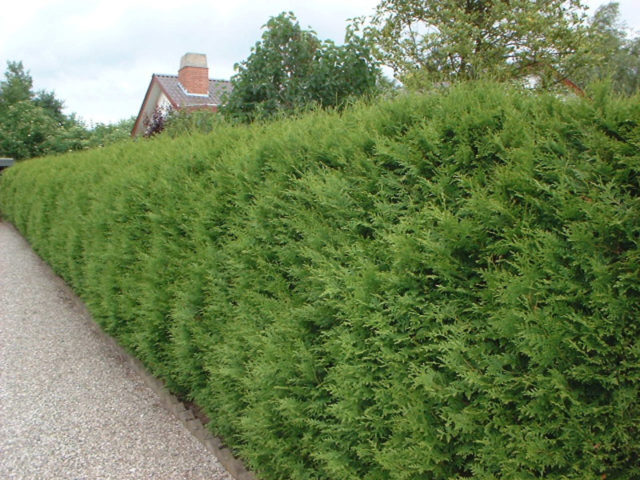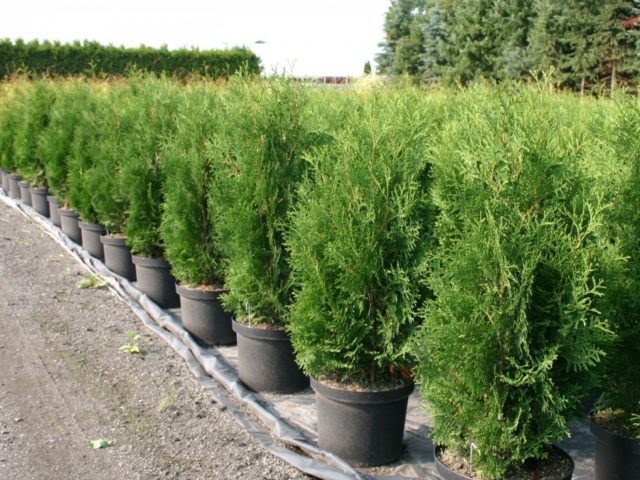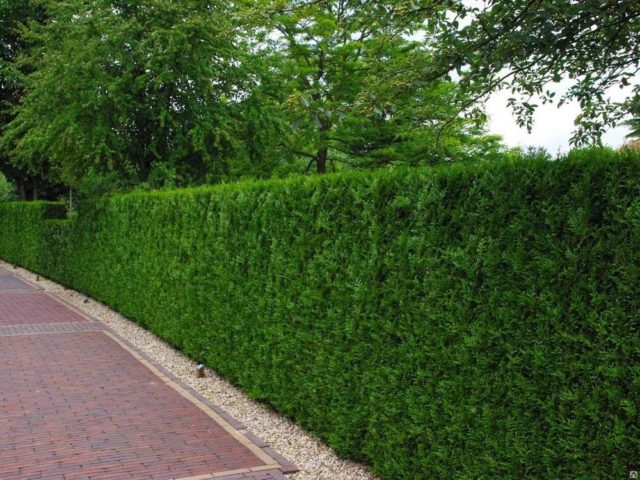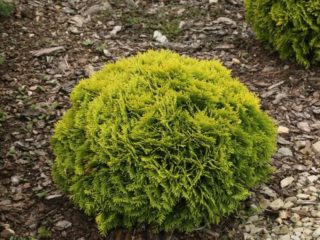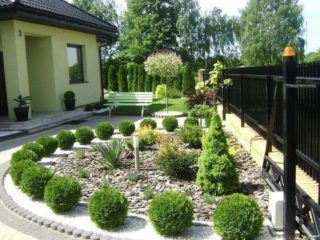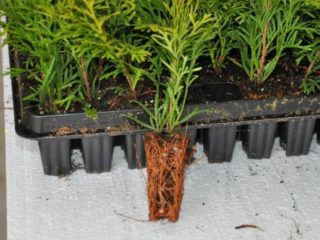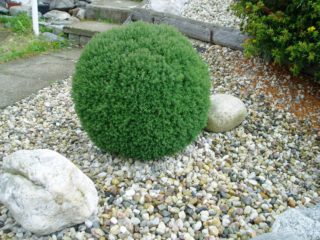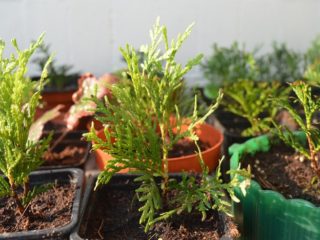Content
- 1 Description of thuja Brabant
- 2 The difference between thuja Brabant and other varieties
- 3 The use of thuja Brabant in landscape design
- 4 Breeding features of thuja Brabant
- 5 Planting and caring for thuja Brabant
- 6 Western Thuja Brabant Care
- 7 Creating a hedge from thuja Brabant
- 8 Pests and diseases
- 9 Conclusion
- 10 Testimonials
The use of conifers in landscape design is gaining more and more popularity every year. Thuja Brabant is one of the most popular representatives of its genus. Due to the ease of planting and unpretentious care, this tree has gained immense popularity among owners of personal plots.
Description of thuja Brabant
This species is one of the representatives of the western thuja. The needles of Brabant have a beautiful light green hue. In late summer and autumn, the tree can change the color of the crown tips to greenish yellow. Unlike most of its counterparts, Thuja Brabant does not turn yellow and retains a green tint throughout the winter period.
The bark on the trunk of a plant can have a color ranging from light brown to deep brown, and due to its structure, it can slightly flake off. Flowering occurs in the spring from mid-April to late May. At this time, Brabant has small, 1 cm in size, ovoid or oblong cones.
Breeders bred a related thuja variety from this plant - Golden Brabant. From the name you can guess that the leaves of this tree have a yellow-green color close to gold. A photo and description of this variety of thuja Brabant proves that with age the tree loses its crown density, its branches become more rare and friable.
Sizes of an adult plant
In its natural habitat, an adult thuja Brabant plant can reach an impressive 20-meter height. Moreover, the diameter of its crown can be up to 4 m.In the middle lane and in the Moscow region, the usual sizes of thuja Brabant rarely exceed 4-5 m.
Most often, the owners of personal plots under the cultivation of thuja mean two options. On the one hand, it is a large tree with a dense and lush crown. Another option is to periodically cut the plant and in fact turn it into a shrub up to 1 m high - most often this is used to create hedges.
How thuja Brabant grows
One of the differences between this type of plant is its rather rapid growth and green mass gain. For a year of active vegetation, Brabant can grow up to 40 cm. The increase in crown diameter over the same period can be up to 15 cm. It is not surprising that in terms of growth rate this type of thuja is second only to the leader among all conifers - Siberian larch.
For a tree of this type, a conical crown is inherent. At the same time, it stands out among other thujas for its compactness and branchiness. Often the branches of Brabant descend to the very ground.
Thuja Brabant characteristics
Like any coniferous plant, Brabant perfectly tolerates cold snaps and sudden temperature changes.In the middle lane, this tree easily survives long frosty winters and severe soil freezing. According to research, thuja can easily withstand temperatures as low as -35 degrees. In this case, the roots begin to die off only in the case of cold weather for a week.
This variety is very easy to care for. It calmly refers to a different type of substrate, although it grows best in loamy soils. The plant tolerates both short droughts and fairly strong soil moisture without problems.
Almost every plant can be vulnerable to various pests and diseases, and thuja is no exception in this case. Accustomed to the warm southern climate, it can be affected by a large number of plant diseases in the middle lane. It is very important to pay attention to the appearance of the plant - a change in the color of the leaves can promise serious consequences, up to and including death.
The difference between thuja Brabant and other varieties
Every owner of a country house dreams of a beautiful and well-kept plot. The choice in favor of thuja is explained by the magnificent appearance, which gives the site a neat appearance. But every time when choosing the right variety, novice gardeners are faced with the problem of choosing from almost 120 species of this tree. Moreover, each variety has its own characteristics and differences.
According to reviews, thuja Brabant differs from other varieties in an unusually high growth rate. With proper tree care, annual growth is up to 80 cm in height. If this thuja was chosen to create a hedge, then it needs more frequent pruning of needles. If Brabant is started and not cut in time, it can grow to a huge size and its crown will lose its beautiful shape.
Which is better: thuja Brabant or Smaragd
These 2 types are considered to be the most popular among gardeners and landscape designers. Thuja Smaragd, unlike Brabant, grows more slowly, adding only 20 cm per year. At the same time, an adult plant boasts a thicker crown. Other features of Smaragda are:
- longer life span - up to 110 years;
- ideal for cold winters down to -40 degrees;
- grows in almost any soil;
- during growth, it releases phytoncides - natural substances that purify the surrounding air;
- the ability to choose a variety with both green and golden needles.
In terms of applicability, appearance and frost resistance, thuja Brabant and Smaragd are very similar. However, the rate of growth comes to the fore here. If the owner of the site is not in a hurry, he is ready to wait several years until the tree grows, you can choose Smaragd. Brabant is chosen when it is necessary to make a hedge or a beautiful composition of coniferous trees as quickly as possible.
Which thuja is better: Columna or Brabant
Columna is the same variety that can be most often found in city parks, on the grounds of schools and government institutions. The tree is characterized by a straight stem, from which numerous branches extend at right angles. Sapling sellers often claim that the plant is incredibly fast growing. However, in real life, such a thuja grows no more than 15-20 cm per year.
This tree has taken root so much in the middle lane that it is not afraid of either dry summers or long cold winters. It also grows well in any type of soil. One of the most important points when choosing a Columna is that, as such, it does not require pruning, a beautiful crown is formed on its own. By pruning, only the height of the thuja is regulated.
For all its merits, Columna still loses to Brabant not only in growth rate. An important aspect when working with Columna is that it is quite difficult to grow a beautiful hedge from this variety.Trees will have to be planted as close to each other as possible so that their crowns are intertwined into a single one. Columna is better suited for decorating parks, Brabant - for personal plots.
The use of thuja Brabant in landscape design
Thuja Brabant is one of the most popular plants in landscape design. Thanks to its flexibility in pruning and fast growth, even a novice gardener can easily turn a simple plot into a real work of art with its help. Among the most popular ways to use thuja Brabant are: an alley, hedges and planting single trees.
To make a beautiful alley of evergreen trees, the designer draws a straight line along the site, then seedlings are planted at a distance of 3-4 m from each other. For a hedge, the distance between the plants is made much smaller - from 0.5 to 1 m.If the gardener decided to use single plants to decorate his site, the thuja seedlings are planted in the order specified by the project. When planting trees alone, pruning can be approached with great artistry. Depending on the skill of the gardener, the figure of any animal or bird can be made from Thuja Brabant. The crown of an adult plant can be:
- conical;
- pyramidal;
- spherical;
- helical;
Also, thuja will help to embellish the gazebo located on the site, decorate the recreation area. If the size of the site allows, you can make an extravagant green labyrinth. If you want to surprise your neighbors, then when planting an alley or hedge, you can alternate two varieties of thuja - Brabant and Golden Brabant. The result is an unusually beautiful two-tone wall.
Breeding features of thuja Brabant
The breeding methods of this variety of thuja are similar to all gymnosperms. There are two most popular methods - using cuttings and seeds. Reproduction of thuja by seeds is the key to getting a healthier plant. However, the rather long time span of this method is not in favor of this method.
To get the seeds of Brabant, cones are harvested from an adult tree in the spring. The cones are left in a warm place until they crack - after which the seeds are removed from them. They are placed in wet sand for a couple of days. Slightly swollen seeds are planted in a prepared soil mixture, mixed from turf, sand and peat in a ratio of 3: 1: 1. After germination, a container with earth is placed in a cool place so that thuja Brabant gets used to the cold and gets stronger.
Another way to propagate thuja Brabant is by cuttings. To get ready-made seedlings, small shoots 10-15 cm long are cut off from an adult tree. They are placed in a container with water or in highly moistened soil. When the first roots appear, the cuttings are transplanted into a container with prepared soil and create greenhouse conditions for it in the house. Only after the first wintering are the seedlings ready for planting in open ground.
Planting and caring for thuja Brabant
Seedlings ready for planting should have a developed root system - this will allow them to take root in a new place as quickly as possible. Proper planting and caring for Thuja Brabant is the key to her health. Another important point is the size of the seedling prepared for transplantation. The best choice would be 2-year-old thuja with a height of about 40 cm, with a developed pyramidal crown.
Before planting in the ground for Thuja Brabant, it is necessary to prepare planting pits. It is best to do this in advance, for example, in late autumn. The dimensions of the pit should be 80x80x80cm. The deeper the pit, the better for the further development of the thuja root system.
Recommended timing
Thuja is a southern plant, so it is best to avoid planting it before winter. When planted in September-October, the fragile roots of the plant may not withstand strong winter cold snaps. At the same time, in the middle lane and more northern regions, cold weather can come already in the middle of autumn, which will inevitably destroy the seedlings.
It is best to plant Brabant in mid-spring. In the second and third ten days of April, warm weather is usually established without subzero night temperatures. According to the observations of gardeners, in the spring the chances of thuja to take root in a new place are about 10-15% higher compared to the autumn planting.
Site selection and soil preparation
It is believed that thuja Brabant is absolutely not whimsical to the soil. However, the correct soil is a guarantee of rapid growth and plant health. On poor soils, Brabant will also grow, but will lose the maximum crown density.
The Brabant variety is one of the most light-loving among thujas. At the same time, constant exposure to direct sunlight leads to dehydration of the shoots of the plant and, as a result, to problems with wintering. The best place would be a place that is closed from direct rays, but not too shaded.
Landing algorithm
To get a healthy plant with a beautiful crown, it is advised to plant thuja Brabant according to a certain algorithm. The sequence of actions for planting in open ground is as follows:
- A drainage layer is laid out at the bottom of the planting pit. Broken brick or expanded clay of a large fraction is ideal for this.
- Thuja is placed in the pit so that its root collar is approximately at the same level with the ground.
- The pit is covered with soil prepared in advance - a mixture of leafy earth, peat and sand.
It is very important that the root collar is exactly at ground level. It is believed that if it is buried in the ground, thuja Brabant will die. Raising the root collar above ground level will make it practically defenseless during severe cold weather.
Western Thuja Brabant Care
Thuja is unpretentious and, in comparison with other plantings, requires much less care. However, in order to obtain a healthy plant, a standard set of care for Brabant should be carried out. It includes loosening the soil, periodic watering and feeding, timely cutting and proper preparation for wintering.
It is important to periodically loosen the soil around the thuja. In loosened soil, Brabant grows much faster. It is also important to periodically weed the soil around the tree. Excess plants and weeds will absorb water, depriving them of essential nutrition.
Watering and feeding schedule
After planting, young seedlings require periodic watering. The first 2-3 months after planting in open ground, the Brabant thuja is watered once a week. If the planting time coincided with the dry period, the frequency of watering is increased to once every 4-5 days. Adult plants do not need constant watering - the soil around the thuja is moistened only during severe droughts.
In early spring, a complex fertilizer for conifers is applied. This helps the thuja to move away from hibernation faster and start growing faster. This is done in late March or early April after the snow has completely melted.
How to trim Tuyu Brabant
Thuja pruning begins, as a rule, from the third year of the plant's life. By this time, the tree will accumulate a sufficient amount of green mass, which must be given a noble appearance. As soon as Brabant reaches the height necessary for the gardener, the top is periodically cut to him, stopping his growth.
Thuja Brabant is sanitary pruning every spring.After the snow melts, you need to inspect the plant and remove frost-damaged shoots.
Preparing thuja Brabant for winter
In the first years of life after disembarkation, thuyu Brabant must be protected from severe frosts. Young bushes are covered with spruce branches or a special protective film. After 3-4 years of development, the thuja will get stronger and will no longer need shelter from the cold.
An important aspect in preparing thuja Brabant for winter is the garter of its crown. Under the weight of snow, weak shoots can deteriorate and break, which will lead to the loss of the integral appearance of the crown. The strapping is done with twine - the distance between each circle of the rope should be 30-40 cm.
Creating a hedge from thuja Brabant
A thuja hedge is a great way to fence your site or divide it into zones. Brabant allows you to achieve a thick and impassable wall that can cover the site better than any fence. Among the advantages of a thuja hedge are:
- Creation of a great atmosphere for relaxation.
- Hiding ugly places on the site - a vegetable garden or a compost pit.
- Purification of the ambient air due to the release of phytoncides.
- Shelter from dust, exhaust fumes and unnecessary noise.
- Green wall at any time of the year.
In addition to the hedge, you can create small living fences. Such curbs up to 40-50 cm high will decorate the site and help highlight its most significant parts. With such a compact hedge made of thuja Brabant, you can, for example, fence off a recreation area from fruit plantings.
How to plant thuja Brabant for hedges
The term for planting thuja seedlings to create a hedge does not differ from planting stand-alone plants. It is produced in mid-spring. Loosening in the first 2 years of life is carried out along the entire length of the fence on both sides. Watering in the first months should be regular in order to get the finished result as quickly as possible.
Since the planting hole for the tree must be quite impressive in size, it is much easier to make one trench. The depth of the trench for thuja Brabant should be at least 80 cm, width 60-70 cm. The bottom of the trench is also covered with a layer of drainage. Saplings are planted at a distance of 0.5-1 m from each other. Brabant has a dense and branched crown, so you should not plant thuja too close to each other.
Thuja Brabant hedge care
Lovers of natural beauty may not cut their hair at all Brabant. Its spreading branches will look great even without additional pruning. You can create a wilderness area on the site that is fenced off from the rest of the world.
Otherwise, caring for a thuja Brabant hedge almost repeats the actions of maintaining the health of a tree growing separately. Thuja needs periodic watering, loosening the soil around the trunk, weeding, and removing shoots damaged in winter.
Features of a thuja Brabant haircut
Thuja hedges are cut in several stages. The very first pruning should be done in early spring - at this time the plant has already accumulated enough strength for further vegetation. During this period, sanitary pruning is performed, as well as the removal of strongly protruding branches. The second haircut is done in August, when the thuja begins to prepare for wintering.
To simplify the process of trimming and leveling Thuja Brabant hedges, a large mesh metal mesh can be used. It is pulled along the green wall, after which the shoots sticking out of the cells are cut off. After cutting, often a large number of shoots remain, which are convenient to use as cuttings for further breeding.
Pests and diseases
Tuyu Brabant should be periodically examined for diseases. Most often they appear in the form of yellowed and darkened leaves.Brown spots on the branches and trunk of a tree most often indicate the onset of a fungal disease. All damaged shoots are pruned and burned to stop the spread of the disease to healthy parts of the thuja.
Preventive treatment of thuja from the fungus is carried out with a solution of 0.2% Fundazole. This treatment is carried out every 2 weeks for 3 months from the moment the first signs of a fungal infection are detected. For prophylaxis against harmful insects, liming of the lower part of the tree trunk is used.
Conclusion
Thuja Brabant is an ideal evergreen for a backyard. With its help, you can make a beautiful well-groomed alley or a high hedge. Subject to the rules of planting and care, you can get a healthy plant that will delight the eye with a lush crown every day.
